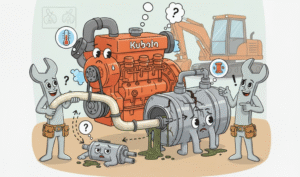
Kubota hydraulic filter bypass events are high-risk situations that require operators to make fast, informed decisions. This article provides a top-down approach: starting with a field-ready checklist you can use immediately, then expanding into detailed explanations, emergency fixes, proper repairs, preventive strategies, and advanced insights into maintaining Kubota hydraulic systems.
Field-Ready Checklist: Kubota Hydraulic Filter Bypass
Step 1: Immediate Safety
- ✔ Lower all hydraulic implements.
- ✔ Shut off the engine.
- ✔ Relieve system pressure at the control valves.
- ✔ Put on PPE (gloves, goggles, protective clothing).
Step 2: Quick Diagnosis
- ✔ Look for sluggish loader or hitch performance.
- ✔ Feel for overheating at filter housing or hydraulic lines.
- ✔ Check fluid condition: cloudy, burnt, or particle-filled fluid is a bypass sign.
Step 3: Emergency Bypass Setup
- ✔ Remove clogged filter (if unusable).
- ✔ Install bypass plug or secure bypass line.
- ✔ Operate only at reduced loads.
- ✔ Strict time limit: ≤10 hours.
Step 4: Implement Permanent Fix
- ✔ Install OEM Kubota filter (example: 67700-00650; verify model).
- ✔ Replace seals/O-rings (67700-00660; verify model).
- ✔ Refill with Kubota-approved hydraulic fluid.
- ✔ Torque housing per Kubota specs.
Step 5: Prevent Recurrence
- ✔ Replace filter every 300 hours (dusty/high-load: 150–200 hrs).
- ✔ Oil sample every 250 hrs for contamination tracking.
- ✔ Train operators on early warning symptoms.
“The checklist buys you precious hours, but permanent repairs protect your machine long-term.”
Understanding Kubota Hydraulic Filter Bypass
A bypass event occurs when the Kubota hydraulic system cannot push oil through the filter due to clogging. The bypass valve opens automatically to keep fluid circulation active. This saves the system from collapse—but at the cost of exposing precision components to unfiltered oil.
System Design and Purpose
- Bypass valve activation pressure: typically 25–45 PSI differential across the element.
- Protects against filter collapse and loss of hydraulic flow.
- Utilizes spring-loaded relief seats to reroute flow.
- Designed for last-resort emergency—not continuous operation.
Symptoms and Diagnostics
Warning Indicators
Hydraulic LossReduced lift power, slow hitches, “sputtering” performance.
System OverheatWarm housings, elevated oil temps, erratic noises.
Contaminated FluidBurnt-smelling, cloudy, or thickened hydraulic oil visible on dipstick.
Advanced Diagnostic Tools
- Differential pressure gauges across filter housing. Check it with a Hydraulic Flow Meter.
- ISO fluid cleanliness meters and portable particle counters.
- Viscosity tests detecting high-heat breakdown.
- Water contamination detection strips.
“Most bypass conditions can be predicted by fluid testing—don’t wait until it forces the valve open.”
Emergency Field Repair Procedures
- 1 Lower implements, shut engine, and cycle controls to relieve pressure.
- 2 Remove blocked filter; inspect for cone collapse or debris.
- 3 Insert bypass plug or connect external bypass line kit.
- 4 Operate on light-duty tasks only, no heavy lifting or PTO stress.
Limit of use: 10 hours maximum. Exceeding this risks heavy system contamination.
Proper Repair and OEM Replacement
Service Steps
- Prepare by cleaning exterior housing and staging OEM filter and O-ring kit.
- Remove housing bolts evenly to avoid warping the seating surface.
- Inspect valve spring, sealing seat, and housing walls.
- Replace with Kubota-verified element and seal kit.
Part Verification
- Filter Element: 67700-00650 (verify by model/serial)
- O-ring Service Kit: 67700-00660 (verify before order)
Emergency Bypass vs. Proper Repair
| Aspect | Emergency Bypass | Proper Repair |
|---|---|---|
| Usage Limit | ≤10 hrs | Full service life |
| Oil Quality | Unfiltered flow → contamination risk | Restores full filtration |
| Long-term Cost | System wear ↑, repair costs escalate | Protects pump, valves, cylinders |
| Reliability | Temporary & risky | Stable Kubota-approved solution |
Preventive Maintenance & ROI
Intervals
- BX models: every 300 hours.
- Severe service: 150–200 hrs.
- Normal farm: 400 hrs+
Economic Breakdown
Fluid 5–15 gallons: $50–200
Downtime: $100–500/hr loss
Pump rebuild (contaminated oil failure): $1,500–3,500
Cylinder replacement: $800–2,000
Every $1 spent in preventive filter and fluid maintenance can recoup $4–7 in avoided failures.
Case Studies: Real Kubota Field Issues
BX2370 Filter Blowouts
Issue: Repeat filter rupture due to clogged return line and high relief pressure.
Fix: Cleaned return lines, verified correct filter, recalibrated valves.
Result: Resolved chronic failures.
L245DT Weak Hydraulics
Symptoms: Loader stalled unless high RPM.
Diagnostics: Inspected pressure blocks, checked relief valve.
Fix: Full fluid/filter service, adjusted valve.
Result: Restored full hydraulic lift strength.
L3901 HST Collapse
Issue: HST filter cone collapsed during 50 hr service.
Cause: Oil heavily contaminated, 80/90Wt thickness.
Solution: System flush + root cause trace.
Result: Prevented recurring failure.
Future Tech: Smarter Maintenance
- IoT-linked differential sensors for real-time filter health.
- Predictive AI alerts based on oil particle trend analysis.
- Automated maintenance reminders via app dashboards.
- Environment-compliant recycling protocols for fluids/filters.
Conclusion & Recommendations
- Emergency bypass buys time, not a solution.
- OEM replacement restores hydraulic health.
- Consistent maintenance saves thousands in repair costs.
- Future-ready monitoring will improve uptime dramatically.
Invest in prevention. The cost of a filter is small—the cost of system failure is massive.
Check us out for more at TractorPartsCentral.com
FAQs
How long can I run in bypass?
Only up to 10 hours under reduced loads. Prolonged bypass risks catastrophic wear.
What fluid should I use?
Kubota Genuine Hydraulic Fluid or OEM-approved equivalent. Never reuse contaminated oil.
Are filter part numbers universal?
No. Always verify with Kubota serial number lookup before replacing filter or seals.
What’s the simplest prevention?
Routine filter changes and oil sampling. It prevents 90% of bypass scenarios.
